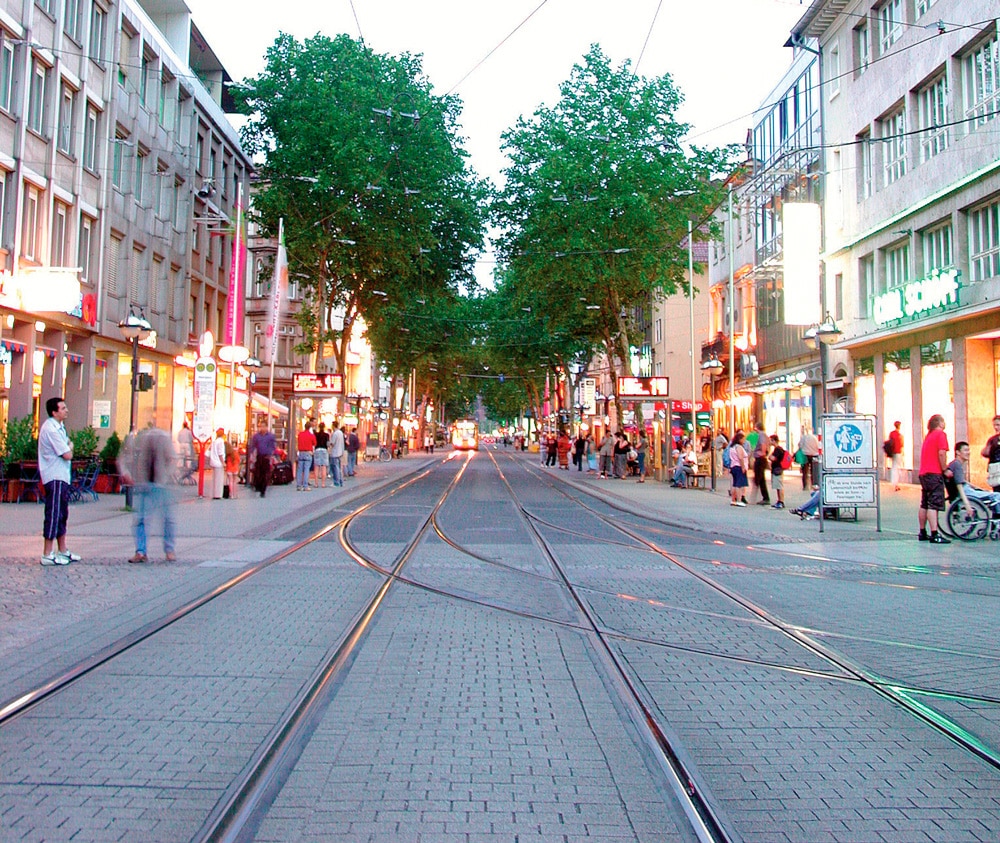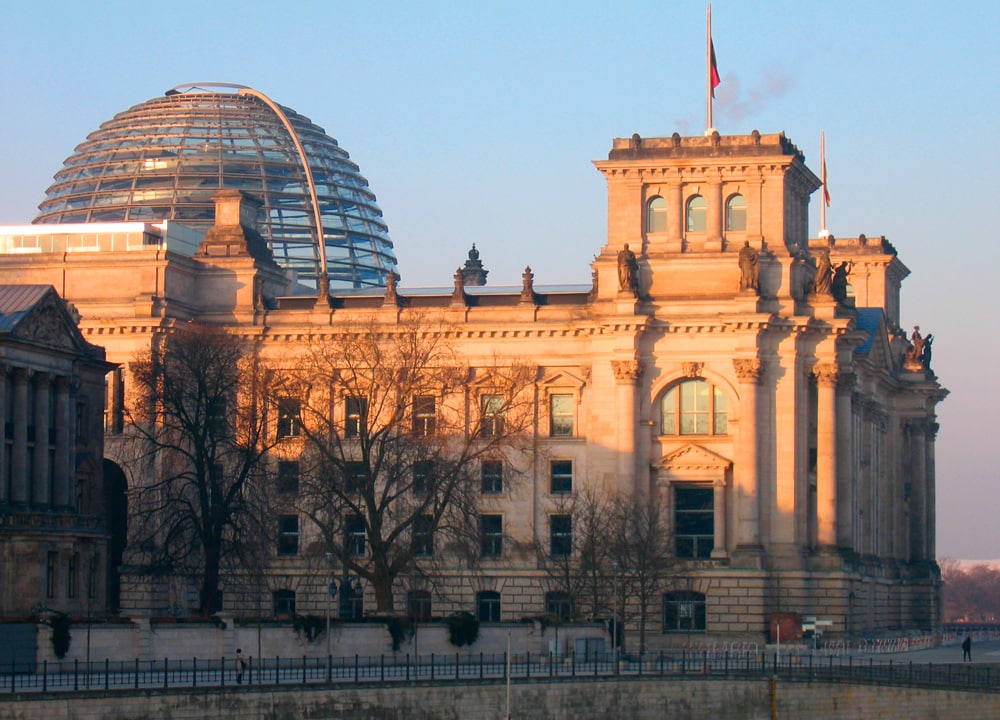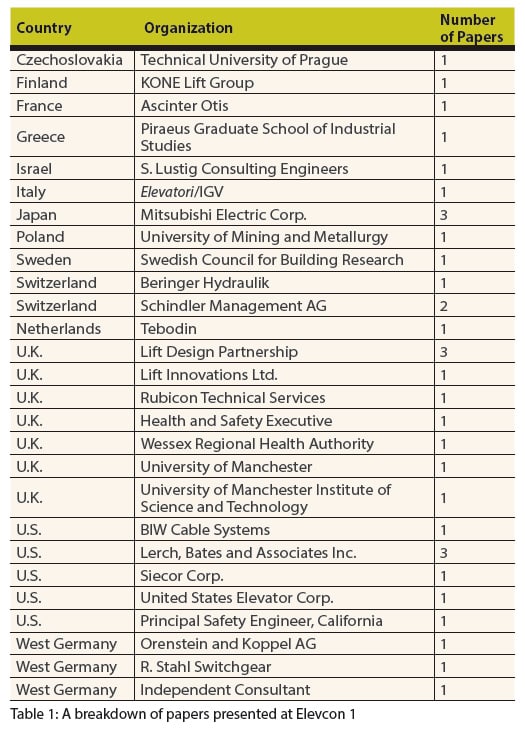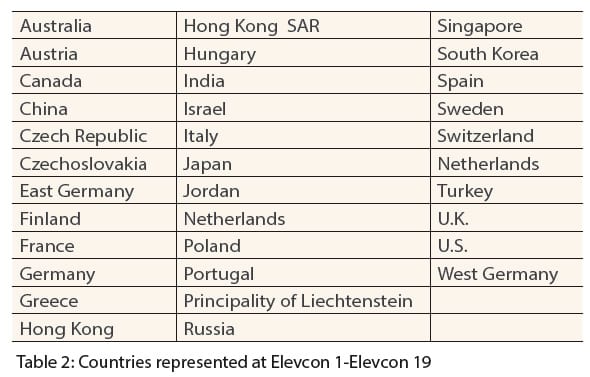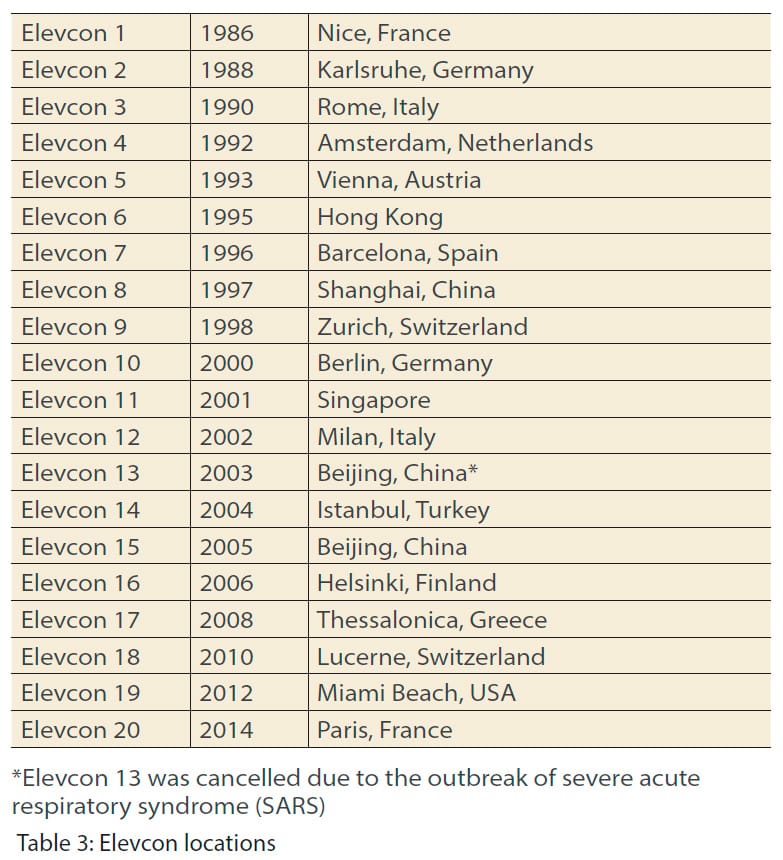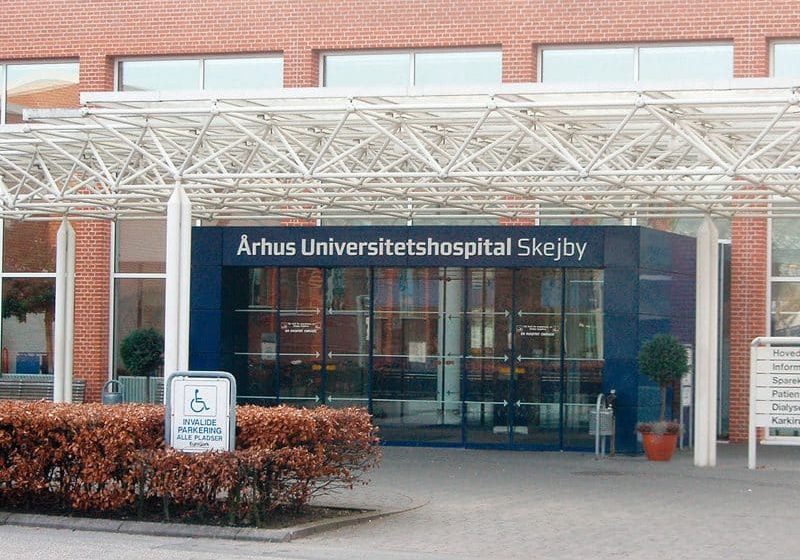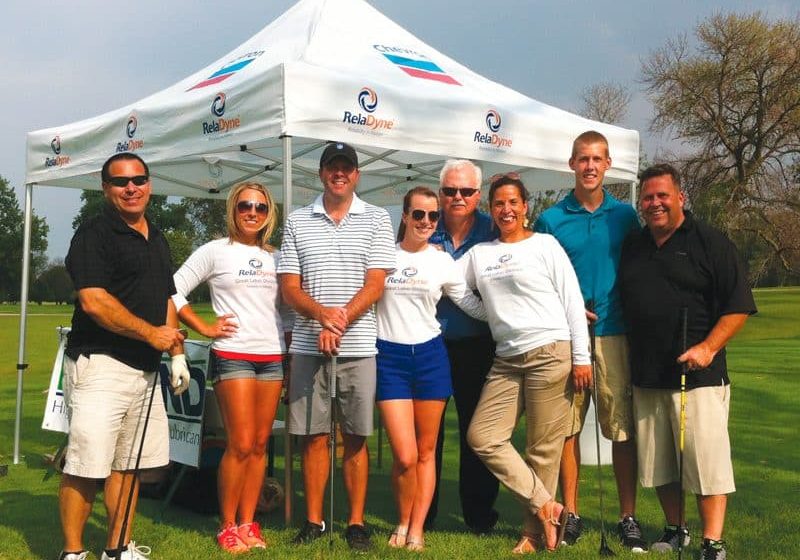by Dr. Lee Gray, EW Correspondent
The constitution of the International Association of Elevator Engineers (IAEE) includes the following concise statements concerning its purpose and goals:
“The rapid growth of the building industry and associated technologies demands parallel growth in the field of vertical transportation. Both the freight and passenger elevator industry need qualified engineers in the field whose knowledge keeps pace with technological and scientific developments. The IAEE will provide a forum for the exchange of information and experience vital for training and education.
“The aims of IAEE are summarized as:
- The definition and promotion of vertical transportation* engineering as a specialized profession
- The promotion of international standards
- The encouragement of higher professional standards throughout the industry
- The promotion of scientific and technological expertise
- The cooperation between members
*The term vertical transportation includes escalators.”
These principles have guided the paper and presentation selection, as well as the organization of all Elevcon meetings. Therefore, it is appropriate to utilize these principles as a critical filter or lens through which to view and assess the purpose, impact and importance of the 18 Elevcon meetings that occurred between 1986 and 2012.
A Forum for the Exchange of Information and Experience
Elevcon 1, held In Nice, France, in February 1986, established a pattern for all subsequent meetings in its organization and content. This inaugural event included a diverse set of presentations delivered by an equally diverse set of speakers. The papers were published in a single volume following the meeting. (At all subsequent Elevcon meetings, the publication of the proceedings has coincided with the event, making papers readily available to meeting attendees). The meeting’s 34 papers were written by authors from 14 countries who represented 17 companies (elevator manufacturers and consulting firms), four universities, four governmental agencies and one magazine. While the goal of assembling an “international” collection of papers was partially achieved in the diversity of the authors’ nationalities, the meeting had a decidedly European bias – only three of the 14 countries were non European: Israel, Japan and the U.S. Each country was also not “equally” represented in the number of papers delivered; thus, their presence varied considerably (Table 1).
Thus, while only three non-European countries were present, their representatives delivered approximately 30% (11 of 34) of the meeting’s presentations. The involvement of individual authors also varied: V. Quentin Bates, Michael Godwin and Dr.-Ing. Joris Schroeder each delivered two papers. Finally, there were also five co-authored papers, two of which employed a pair of authors; one that employed a team of four authors; and two that employed teams of five authors. The latter two groups produced the papers delivered by Mitsubishi Electric Corp. Thus, although this was the only Asian company represented at the meeting, its efforts embraced a total of 12 engineers who comprised the three teams that produced the company’s papers.
This detailed examination of Elevcon 1 illustrates the organizers’ attempt to assemble an international group of speakers and authors and their varying levels of success. Elevcon 2 (1986) followed a similar pattern – only four of the 13 countries that contributed speakers were non European: Australia, Israel, Japan and the U.S. Once again, Mitsubishi Electric was the only Asian participant. Elevcon 3 (1990) marked a distinct turning point in the IAEE’s effort to expand the event’s international scope – six of the 12 countries that contributed speakers were non European: Australia, Canada, Israel, Japan, Jordan and the U.S. Equally noteworthy was the increased presence of Asian companies. In addition to Mitsubishi Electric, representatives from Hitachi Ltd., Ryoden Service Co. Ltd., and Toshiba Corp. also presented papers. The common practice in Japanese companies of engaging teams of authors also resulted in a higher level of diversity among the meeting’s contributors: 15 of the 36 authors represented Japanese companies. In fact, 21 of the contributing authors represented non-European countries, and 13 of the meeting’s 30 papers were delivered by these authors.
The slow but steady increase of international Elevcon speakers and authors has continued since 1990. In 1992, representatives from China and Hong Kong presented for the first time; this was followed by India (1993), South Korea (1996), Turkey (1998) and Singapore (2001). During this same period, the number of European countries participating also increased, and, to date, 34 countries have contributed speakers to Elevcon (Table 2).
Included in this list are, of course, three former countries: Czechoslovakia, East Germany and West Germany. Hong Kong’s status has also changed, and it is now typically referred to as “Hong Kong SAR,” reflecting the city’s semiautonomous relationship with China. The increasing international character of the meetings’ presenters was further enhanced by the decision to hold Elevcon meetings outside of Europe (Table 3).
It is of interest to note that the tables here do not include countries from South America. While there may be IAEE members from South America, it is intriguing that the continent has not contributed papers to be presented. Finally, it should be noted that the authors of the 586 papers presented between 1986 and 2012 represented more than 225 different companies, universities and other organizations. Thus, the Elevcon meetings have clearly achieved the goal of becoming a meaningful industry forum “for the exchange of information and experience vital for training and education” (IAEE Constitution).
A Specialized Profession
The published Elevcon proceedings constitute a unique body of evidence that permits an examination of the papers’ authors as constituting a “specialized” professional group. This evidence consists of over 400 author biographies, the biographies of board members that appear in select proceedings, and the authors’ corporate, academic and institutional affiliations. The content of the biographies also reflects the personality of the individual authors through what has been included or emphasized. This is particularly interesting in cases where authors have contributed papers to multiple Elevcon meetings, which permits a comparative reading across several years. In a few cases, this reading reveals the presence of students or younger engineers who utilized their participation at Elevcon as an important aspect of their professional development. A careful reading of these biographies also reveals a subtle change that occurred from Elevcon 1 to Elevcon 19. Since 1986, there has been a gradual increase in the number of younger participants, versus that of industry veterans.
The presence at Elevcon of “industry veterans,” “mid-career,” and “younger/entry-level” members of the vertical-transportation industry raises interesting questions about the differences between generations of engineers. Many members of the “older generation” who participated in the first Elevcon meetings attended traditional mechanical or electrical engineering programs, began their careers in a variety of fields and eventually found their way into the world of vertical transportation. A few members of the next generation (today’s industry veterans) had the opportunity to pursue specialized university programs in elevator engineering, such as the program developed by Dr. Gina Barney at the University of Manchester Institute of Science and Technology. However, while other specialized programs have been developed over the years, such as the MSc in Lift Engineering at the University of Northampton, the majority of emerging elevator professionals attended traditional engineering schools. A key difference between these and past programs is the presence of industry members who often serve as adjunct faculty or lecturers. This may account for what appears to be an increasing number of graduates who enter the vertical-transportation industry immediately following the completion of their degrees and what appears to be an increase in the number of thesis/dissertation projects concerning vertical transportation.
The presence of a dedicated “specialized” professional group is also indicated by the fact that 25% of authors have participated in two or more Elevcon meetings. Dr. Albert So has the distinction of having contributed the most papers: he participated in 13 Elevcon meetings from 1992 to 2010. A similar strength of commitment is found in an analysis of the Elevcon steering committees. Between 1986 and 2012, 55 people served on the various steering committees, and 15 (almost 30%) served on two or more committees. Those with service on five or more steering committees include Sefa Targit (five), Dr. Lubomír Janovsky (six), George W. Gibson (eight), Barney (nine), So (12), John Inglis (13) and Ami Lustig (17). Barney served as chair of the steering committees of the first nine Elevcon meetings (1986-1998), and Lustig has served on every steering committee since 1988 and has served as their chair since 2000.
International and Professional Standards
It would, perhaps, be reasonable to claim that the overall quality of the majority of Elevcon papers is such that they represent a broad survey of professional standards for the period from 1986 to 2012. However, while a review of the 5,761 pages of the published Elevcon proceedings does reveal broad professional themes, concerns and sustained interests, the presence of clearly articulated “international standards” is less obvious. While the word “standards” has different definitions, for purposes here, it will be defined in terms of vertical-transportation codes or similar regulations.
The importance of codes and code development is evident in the author biographies that accompany many of the papers: numerous authors highlight their membership (and leadership) on regional, national and international code committees. However, this professional engagement rarely found its way into Elevcon meetings: only 5% (approximately 30) of the 586 published papers focused on the topic of codes. This small code-related set includes papers that address the unique code requirements of specific countries or settings, papers that address the development of European code standards and papers that attempt to address global code issues.
The first group consists of papers that address codes and regulations in the former East Germany, Hungary, Hong Kong, India, Italy, the Netherlands, Singapore, Spain, Turkey, the U.K. and Vietnam. These papers are, perhaps, the most interesting because they typically touch on the history of local code development, and that code is often discussed in the context of European or North American standards. The second group – papers that concern the development of a European standard code – constitute a more cohesive set of papers. However, while some of the authors attempt to embrace a broader or more global perspective, it is difficult not to perceive these papers as primarily representing an internal, Eurocentric conversation.
The third group, composed of only five papers, attempts to address the prospect of global standards. This final group of code papers is intriguing because the first paper was presented at Elevcon 3 (1990), the second at Elevcon 11 (2001) and the final three at Elevcon 19 (2012). The first paper, “A Review of Code Variations in Europe, USA and Australia,” was written by Inglis. In his introduction, he observed, “It has always been of great concern, both to the suppliers and installers of lifts, why there is so much difference between the codes of one country and that of another.” He concluded his brief comparison of European, American and Australian codes with the optimistic statement, “It would be hoped that sometime in the future, the International Organization for Standardization will deal with the technical aspects of lifts.” In 2001, a team of authors (Hoi Sang Kouk, So and S.K. Liu) presented “On the Idea of Performance Based Lift Codes,” which extended Inglis’ initial global examination and examined the possibility of utilizing the concept underlying performance-based fire codes to create universal lift codes for Europe, Asia, Australia and the U.S. In 2012, following another 11-year hiatus, three papers appeared that addressed the topic of international standards: “Elevator Certification Processes – Global Approach and Regional Certification” by Dirk Schroeter and Carsten Schumann, “On-Going Activities in Elevator Energy Codes, Standards and Classifications” by Richard Fargo, and “Trends in Safety Codes and Standards for Elevators and Escalators” by Esfandiar Gharibaan. Each of these papers utilized comparisons of various national elevator and energy codes to drive their respective arguments.
Elevcon meetings have thus included a small selection of papers on codes, some of which have touched on the need for and possibility of developing international standards. During this same period, papers have focused on what might be termed regional international standards, such as the development of a European lift code. It is difficult to determine the effectiveness or relevance of these collected papers in establishing a meaningful foundation for the articulation of a global elevator code. Nonetheless, the fact that three papers concerning global regulations appeared in 2012 provides evidence that the prospect of achieving this goal has, perhaps, been revived once again.
The Promotion of Scientific and Technological Expertise
More than 700 authors have been involved in the production of the 586 papers presented at the past 18 Elevcon meetings. These authors were employed or associated with more than 225 different public and private entities: elevator manufacturers, consulting firms, universities, government agencies, etc. And, as was observed above, the authors represented more than 30 countries, from North America to Europe to Asia. This broad level of industry engagement effectively demonstrates the success of these meetings as important venues for “the promotion of scientific and technological expertise” (IAEE Constitution). A survey of these papers’ topics reveals current industry interests and concerns. The sustained and continued investigation of some topics (such as traffic analysis) also illustrates how approaches to problems have changed over time and how many of the fundamental questions remain the same. This survey also clearly reveals that the computer, and its application and use in almost every aspect of vertical-transportation design and analysis, has been the most important topic addressed from 1986 to the present.
The importance of Elevcon papers to the profession and to the promotion of new ideas is revealed in several different ways. The first may be considered as a type of internal intellectual consumption. Beginning with papers produced for Elevcon 2, authors have consistently cited papers produced at previous Elevcon meetings. This internal consumption of ideas has allowed authors to position their contributions within the context of past meetings and extend arguments and conversations initiated by their predecessors. A second means of promotion is the publication of the Elevcon proceedings, which meeting attendees receive, and which are often added to corporate libraries and archives. The third form of promotion is the external consumption of Elevcon papers. This occurs through the republication of Elevcon papers in industry trade journals such as ELEVATOR WORLD, Lift Report, Elevation and Elevatori. Readers of these magazines are well aware of the important role these publications play in bringing Elevcon papers to a wider audience. Finally, these papers are also often referenced on and occasionally accessible from corporate websites.
One important potential audience for Elevcon papers and proceedings that has, perhaps, been less effectively pursued is undergraduate and graduate engineering students. A brief survey utilizing First Search-OCLC’s Worldcat database reveals that 25 university libraries currently list Elevcon proceedings in their catalogs. The internationality of these libraries – Australia, Canada, China, Germany, Hong Kong, Ireland, Israel, Singapore, Switzerland, Taiwan, Turkey, the U.K. and the U.S. – suggests Elevcon proceedings have an effective international distribution and, thus, a reasonable presence in university libraries. However, further investigation reveals 12 libraries have only one volume of proceedings, seven libraries have two to four volumes, and six libraries have six to eight volumes. While this search cannot claim to be comprehensive, it appears to reveal that no university library currently holds a complete set of Elevcon proceedings and that most libraries offer their patrons only minimal access to this rich archive of material. A possible future IAEE initiative could involve the digitization of all of the Elevcon proceedings in order to more easily provide them to engineering libraries, thus increasing student access.
Conclusions and Possible Future Projects
This article primarily presents the outlines of a set of parallel investigations that deserve greater attention and that should be more fully pursued. This pursuit is necessary, because these investigations will shed important light on the history of vertical transportation over the past 28 years and the critical changes that occurred in the transition from the late 20th to the early 21st century. Therefore, this conclusion focuses on suggestions for future investigations and contains far more questions than answers. These questions will also be used to highlight topics not addressed in this paper but which deserve attention.
This historical overview has focused almost exclusively on the authors of the papers that provided the primary intellectual content for Elevcon meetings. It would have also been interesting to examine the complete rosters of all attendees for each Elevcon. For example: Elevcon 1 reportedly had 272 attendees from 25 countries, and Elevcon 2 had approximately 70 attendees from 18 countries. It would be interesting to know which countries (and companies) were represented at each meeting. This information could then be compared to the speakers’ profiles to more fully understand the impact and international outreach of the meetings.
The history of the planning and organization of the Elevcon meetings is equally important. This investigation would include explorations of the decisions behind meeting locations and the role of manufacturers exhibitions. A critical aspect of this topic is the history of Elevcon’s founders and their vision for creating this event. Both of these topics would require access to meeting minutes and related materials (letters, etc.). The development of detailed biographies of Elevcon founders and steering committee members would also be an important project. This would permit insights into the world of vertical transportation prior to Elevcon, as well as the changes that occurred as a result of the event. Of course, the history of Elevcon is also integrally connected to the founding and history of the IAEE. This is also a history that deserves attention. The rationale behind its creation, its leadership, and its growth and trajectory from 1986 to the present would be important aspects of this story.
Additional topics for future study were uncovered while researching Elevcon proceedings. The corporate affiliations of the authors included three primary groups: manufacturers, suppliers and consultants. The latter group is of particular interest. The contributions to Elevcon by the members of elevator consulting firms are evident throughout the proceedings. The evidence indicates that the presence of these firms was well established by 1986, and that their members were often recognized as authorities in the field of vertical transportation. This prompts questions about the origins of the modern elevator consulting firm and its changing role in the 21st century.
Authors affiliated with elevator manufacturers also prompt questions due to the way in which these affiliations were described in the authors’ biographies. Between 1986 and 2012, authors gradually shifted from simply identifying their association with a company (i.e., listing the company name) to identifying the specific R&D section or other specialized division within the company. This raises questions about corporate organizational structures, product research and development and manufacturing processes. A comparative examination of the history of regional and international corporate organizations and production/design processes might yield some interesting insights. Finally, the various affiliations of the university-based authors prompt questions regarding research that may have occurred at their respective universities and which theses or dissertations may be resting on library shelves waiting to be rediscovered.
As promised at the beginning of this section, readers of this “conclusion” will have observed that, thus far, no obvious concluding remarks have been offered – the focus has remained on “possible future projects.” This is because the articulation of these projects and the prospect of their pursuit (or of prompting others to pursue them) is, perhaps, the most important result of this investigation. The most exciting thing about attempting to write a history of Elevcon from 1986 to 2012 is that it resulted in a broad, critical outline, which, in turn, has resulted in a new opportunity to fill in the gaps and attempt to complete the story.
Acknowledgements
I want to express my thanks to Elevator World, Inc. for its generous support and willingness to loan me several volumes of Elevator Technology, Proceedings of Elevcon and reports on the events, which aided in the completion of this investigation.
References
[1] G.C. Barney, Editor (1986). Elevator Technology. Ellis Norwood Ltd., Chichester. 354p.
[2] G.C. Barney, Editor (1988). Elevator Technology 2: Proceedings of Elevcon ’88. International Association of Elevator Engineers. 232pp.
[3] G.C. Barney, Editor (1990). Elevator Technology 3: Proceedings of Elevcon ’90. International Association of Elevator Engineers. 280pp.
[4] G.C. Barney, Editor (1992). Elevator Technology 4: Proceedings of Elevcon ’92. International Association of Elevator Engineers. 317pp.
[5] G.C. Barney, Editor (1993). Elevator Technology 5: Proceedings of Elevcon ‘93. International Association of Elevator Engineers. 280pp.
[6] G.C. Barney, Editor (1995). Elevator Technology 6: Proceedings of Elevcon ’95. International Association of Elevator Engineers. 246pp.
[7] G.C. Barney, Editor (1996). Elevator Technology 7: Proceedings of Elevcon ’96. International Association of Elevator Engineers. 302pp.
[8] G.C. Barney, Editor (1997). Elevator Technology 8: Proceedings of Elevcon ’97. International Association of Elevator Engineers. 142pp.
[9] G.C. Barney, Editor (1998). Elevator Technology 9: Proceedings of Elevcon ’98. International Association of Elevator Engineers. 304pp.
[10] A. Lustig, Editor (2000). Elevator Technology 10: Proceedings of Elevcon 2000. International Association of Elevator Engineers. 344pp.
[11] A. Lustig, Editor (2001). Elevator Technology 11: Proceedings of Elevcon 2001. International Association of Elevator Engineers. 240pp.
[12] A. Lustig, Editor (2002). Elevator Technology 12: Proceedings of Elevcon 2002. International Association of Elevator Engineers. 352pp.
[13] A. Lustig, Editor (2004). Elevator Technology 14: Proceedings of Elevcon 2004. International Association of Elevator Engineers. 352pp.
[14] A. Lustig, Editor (2005). Elevator Technology 16: Proceedings of Elevcon 2005. International Association of Elevator Engineers. 280pp.
[15] A. Lustig, Editor (2006). Elevator Technology 16: Proceedings of Elevcon 2006. International Association of Elevator Engineers. 416pp.
[16] A. Lustig, Editor (2008). Elevator Technology 17: Proceedings of Elevcon 2008. International Association of Elevator Engineers. 448pp.
[17] A. Lustig, Editor (2010). Elevator Technology 18: Proceedings of Elevcon 2010. International Association of Elevator Engineers. 464pp.
[18] A. Lustig, Editor (2012). Elevator Technology 19: Proceedings of Elevcon 2012. International Association of Ele-vator Engineers. 408pp.
Get more of Elevator World. Sign up for our free e-newsletter.

